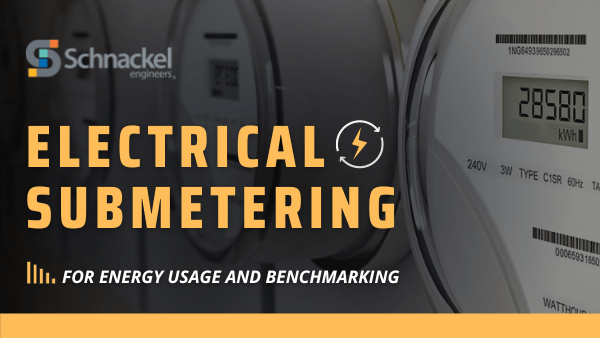Electrical Submetering

Electrical Submetering for Energy Usage & Benchmarking
Once reserved for, nearly exclusively, allocating energy cost to individual occupants of multi-occupant buildings, electrical submetering has seen a dramatic increase in use and applications in recent years. While energy cost allocation is still a widespread use of electrical submetering, developments in electrical submetering technology have resulted in the applications of electrical submetering to be expanded into areas such as:
- Electrical distribution monitoring and alarming.
- Power quality monitoring.
- Transient recording and analysis.
- Electrical distribution system capacity management.
- Utility bill verification.
- Energy usage and benchmarking.
- Energy performance analysis and verification.
While each of these applications are worthy of a dedicated blog, this blog will focus on the energy usage and benchmarking application.
What is Electrical Submetering?
An electrical submeter is an electrical energy measurement device that is located downstream of a building’s utility revenue meter. The device, itself, can take the form of a digital meter or can even be integrated into an electronic trip unit of a circuit breaker.
The device and its associated data acquisition, communications, and software components can measure and record real-time electrical parameters such as current, voltage, real power (kW), reactive power (kVAR), apparent power (kVA), power factor, energy usage (kWh), and harmonics for the circuit the electrical submeter is installed on. The data acquisition, communications, and software components analyze the data and allow users to create custom reports and view customizable web pages and dashboards from any computer and/or mobile device.
An electrical submetering system can be designed to measure the electrical energy consumption associated with an entire switchboard or panelboard, each individual branch circuit, each individual outlet, and anywhere in between. As such, the granularity of an electrical submetering system can be as fuzzy or refined as a facility owner desires.
Code Requirements
ASHRAE 90.1-2013 started requiring electrical submetering systems in certain buildings. The electrical submetering systems are required to separately meter the energy usage associated with specific load groups such as plug loads, interior lighting, exterior lighting, HVAC equipment, etc.
Starting July 1, 2014, the California Energy Code (Title 24, Chapter 6) followed suit. However, unlike ASHRAE 90.1, the California Energy Code does not require the metering equipment to be physically installed. While this requirement does not require electrical submeters to be installed, it does require the electrical design to allow electrical submeters to be installed at a future date.
The 2021 International Energy Conservation Code (IECC) finally caught up with ASHRAE 90.1 and the California Energy Code. Under the 2021 IECC, electrical submetering is required in certain buildings and is required to separately meter the energy usage associated with specific load groups, similar to ASHRAE 90.1. Also like ASHRAE 90.1, the electrical submetering system is required to be physically installed.
Why Submeter?
Code requirements aside, countries throughout the world are implementing initiatives to reduce energy consumption, businesses throughout the world are striving to reduce their carbon footprint and to increase their bottom line, and the possibility of net-zero buildings is no longer a seemingly impossible goal. However, without a means to establish a baseline, advancing towards these goals is futile.
As a simplistic example, if a facility owner wants to reduce their energy usage profile by 5 percent, there are typically several initiatives that can be considered to accomplish the reduction. Adding dimming controls or replacing old HVAC equipment with more efficient equipment may both be under consideration. However, without first knowing how much of the total energy usage profile is attributable to lighting or the old HVAC equipment, calculating the electrical energy reduction is nearly impossible. The same holds true of any energy conservation effort – without a baseline, evaluating each option is often reduced to guesswork.
An electrical submetering system can be implemented to gather the necessary data, thereby allowing a baseline to be established. This baseline data, in turn, provides stakeholders with information that is critical to making informed energy conservation decisions.
Using the simplistic example above, installing dimming controls in a facility where the electrical submetering data indicates the lighting load constitutes only 10% of the total electrical load can easily be dismissed – the facility owner and their employees will likely not tolerate a 50% reduction in lighting levels. However, using the electrical submetering data, they may find that replacing old HVAC equipment with more efficient equipment will result in a 4% energy savings. Although the replacement of the HVAC equipment is not quite the 5% reduction they were looking for, the different data sets allow installing dimming controls and replacing old HVAC equipment to be evaluated together. Based on the data from two data sets, the 5% goal may be achievable because the dimming controls would only need to reduce lighting levels by 10%, which is typically not even perceptible by the human eye, in order to make up the 1% shortfall of only replacing the old HVAC equipment.
Using this data and knowing the cost of their energy usage, the facility owner can then calculate a return on investment. This, in turn, allows the facility owner to set a budget and timelines to implement the energy conservation measures.
Conclusion
The irrefutable data that electrical submetering provides to stakeholders is invaluable in regards to evaluating and implementing energy conservation measures, reducing consumers’ carbon footprints, and increasing consumers’ bottom lines. Without that data, evaluation is often left to conjecture and rules-of-thumb. Contact Schnackel Engineers to see how we can help design an electrical submetering system to take the guesswork out of reaching your energy conservation goals.
Comments